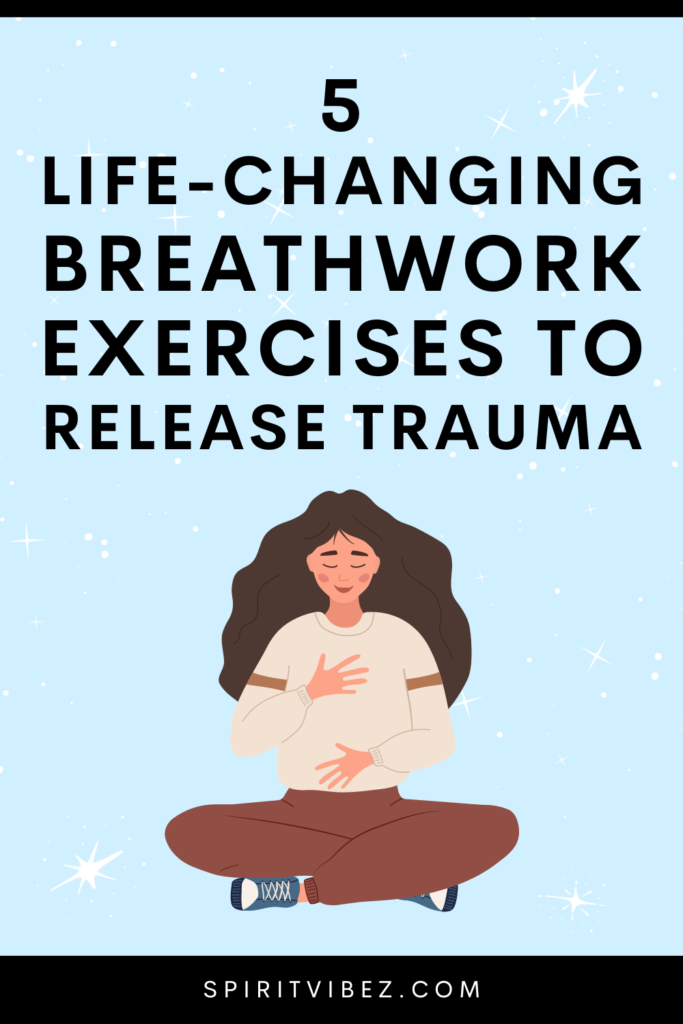Last Updated on September 14, 2023

Trauma often lurks in the shadows, as an uninvited guest that refuses to leave. It can be the aftermath of a single cataclysmic event or the accumulation of life’s relentless storms. Regardless of its origins, trauma casts a long shadow, shaping our thoughts, emotions, and physical well-being.
But what if I told you that the key to releasing this trauma is hidden within your very being, coursing through you with each inhale and exhale?
What if there was a pathway to healing that didn’t rely solely on therapy or medication, but instead tapped into the innate wisdom of your own breath?
This is the beautiful promise of breathwork—a transformative practice that can help release trauma and much more.
In this article, we will journey into the depths of breathwork, unraveling its mysteries and discovering how it holds the potential to unearth buried traumas, soothe shattered souls, and offer the promise of a brighter, more liberated future.
See also:
What is breathwork?
Breathwork is a therapeutic practice centered on conscious control of your breath for holistic healing.
It involves deliberate breathing exercises and techniques to reduce stress, promote relaxation, and release emotional tension. By focusing on the breath, you can enhance your mind-body connection and gain insight into buried emotions and trauma.
Various breathwork methods exist, each offering unique approaches to personal growth and well-being, making it a powerful tool for improving mental and physical health.
What does breathwork do to the body?
Breathwork can have a profound impact on the body, influencing various physiological processes and promoting overall well-being. Here are some of the breathwork benefits on the body:
1. Stress reduction: Breathwork triggers the body’s relaxation response, reducing stress and anxiety.
2. Oxygenation: It increases oxygen supply, boosting energy and mental clarity.
3. Heart and blood pressure: Deep breathing lowers heart rate and blood pressure.
4. Lung function: It enhances lung capacity and efficiency.
5. Detoxification: Breathwork helps remove waste from the body.
6. Pain management: It can ease pain perception and promote relaxation.
7. Emotional regulation: Breathwork techniques regulate emotions and reduce anxiety.
8. Mind-body connection: Focusing on the breath improves mindfulness and self-awareness.
9. Immune function: By reducing stress, breathwork indirectly supports immune health.
Regular practice can maximize these benefits, but it’s essential to approach breathwork mindfully and consider guidance from a qualified practitioner when necessary.
Breathwork to release trauma
There exist many different breathing exercises and below you will find five powerful ones to release trauma. These are some great breathing exercises for beginners.
1. 4-7-8 breathing (Relaxing breath)
This technique is known for its calming effects on the nervous system.
Start by sitting or lying down in a comfortable position.
Close your eyes and take a deep breath in through your nose, counting to four. Then, hold your breath for a count of seven. Finally, exhale slowly and completely through your mouth for a count of eight.
Repeat this cycle several times. This exercise can help reduce anxiety and stress by promoting relaxation and deep breathing.
2. Diaphragmatic breathing (Belly breathing)
This exercise encourages full and deep breathing by engaging the diaphragm muscle.
Begin by placing one hand on your chest and the other on your abdomen. Inhale slowly and deeply through your nose, allowing your abdomen to rise as you fill your lungs. Exhale slowly through your mouth.
The goal is to minimize chest movement while maximizing abdominal movement.
Diaphragmatic breathing helps release physical tension, reduces stress, and promotes a sense of calm.
3. Box breathing (Square breathing)
Box breathing is a structured breathwork technique that helps create a sense of control and balance.
Sit comfortably and inhale through your nose for a count of four. Hold your breath for a count of four, then exhale completely for a count of four. Finally, pause for a count of four before beginning the next cycle.
This balanced breathing pattern can stabilize emotions, reduce anxiety, and enhance mental focus.
4. Alternate nostril breathing (Nadi Shodhana)
This yogic breathing exercise aims to balance the left and right sides of the brain and promote emotional equilibrium.
Sit with your spine straight and close your eyes. Use your right thumb to close off your right nostril and inhale slowly through your left nostril.
Then, close your left nostril with your ring finger, release your thumb, and exhale through your right nostril. Continue this pattern, alternating nostrils with each breath.
Nadi Shodhana can help you feel more centered and emotionally balanced.
5. Holotropic breathwork
Holotropic breathwork for trauma is a more advanced technique typically conducted in a workshop setting with the guidance of a trained facilitator. It involves continuous, deep, and rapid breathing, often accompanied by evocative music.
This practice can lead to altered states of consciousness, facilitating the release of deeply buried emotions and trauma. It is a potent tool for accessing and processing unresolved emotional experiences.
When using breathwork for trauma release, it’s essential to approach the exercises with mindfulness, patience, and self-compassion.
Depending on the severity of the trauma, it may be necessary to work with a therapist or experienced breathwork facilitator to ensure a safe and supportive environment for emotional processing.
If you enjoyed this post on breathwork to release trauma, I would be grateful if you shared it on Twitter, Facebook, or Pinterest! Thank you❤️
📌 PIN THIS POST FOR LATER


Hello, my name is Sara and I am the founder of Spiritvibez, I’m here to guide you on your spiritual journey toward healing, growth, and self-discovery. I believe that true transformation occurs when the mind, body, and spirit are aligned and working in harmony. Through Spiritvibez, I hope to inspire and empower you to deepen your spiritual practice, embrace your authentic self, and begin living your best life.

Dear Sara I just couldn’t stop reading one after the other about self loving , about emotional healing techniques and so on. Loved your style of writing as if you could understand n feel the bond you connect with your readers is very thoughtful. Yes, am a v strong individual always sorting my way through issues , troubles and many such hurdles in life. There are many things you said made me smile cause that’s how I’ve been dealing with these issues. At the same time strong people like us can’t talk about our issues with others , so reading your articles made me feel confident knowing am on the right track. Self importance and care comes before everything. The mind needs to stay happy to stay positive . Thankyou for all the advice and guidance you provided . It’s a good feeling. Will start practicing breathing techniques. God bless you n a tight hug 💝
I’m touched by your kind words and thrilled that you found resonance in the articles. It’s wonderful to hear that you feel affirmed that you are on the right path. Best of luck with the breathing techniques, sending much love and light ❤️